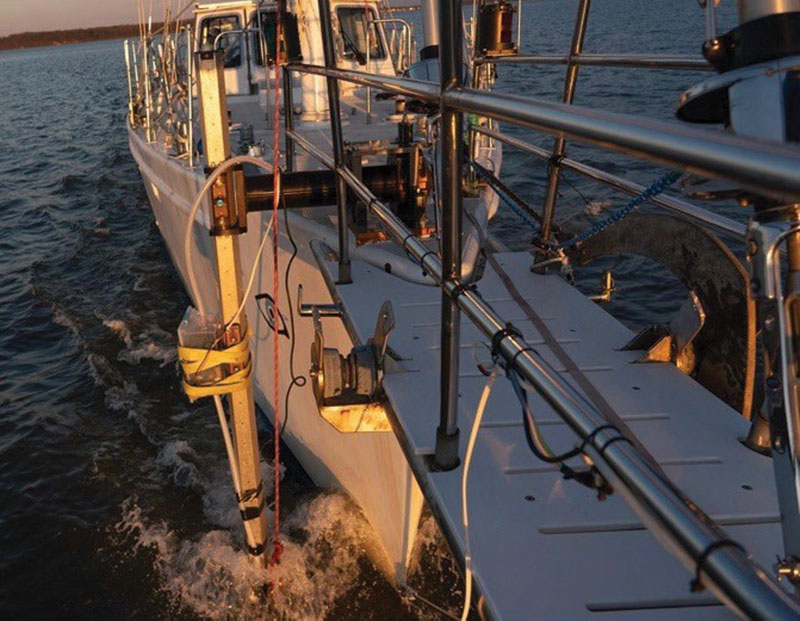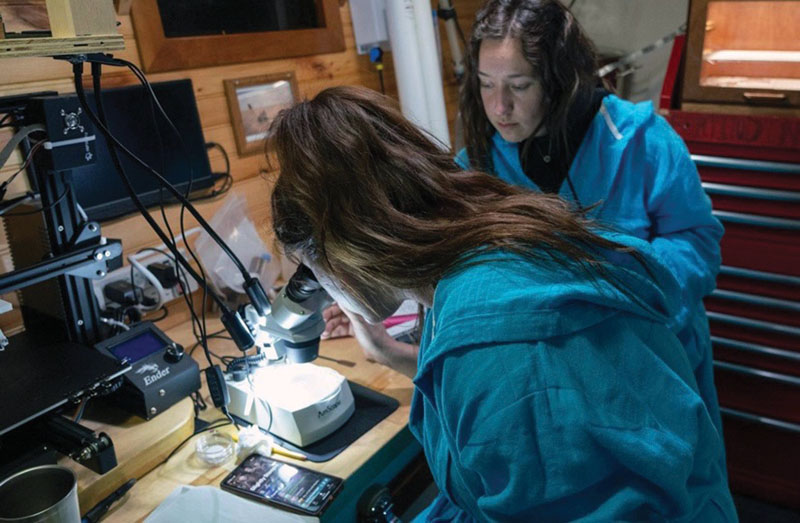An unscientific name for a rising concern in the Chesapeake and beyond.
No fluff. That’s been Matt Rutherford’s mantra for years. He uses it to stay on track. His primary goal in roaming the seas as one of America’s greatest ocean adventurers is to use his sailing skills to advance knowledge, to discover facts, to find and help solve problems, to bring back data. Fluff, to him, is boating for fun or profit without a deeper purpose.

So, imagine their chagrin when he and his longtime science partner at the Ocean Research Project (ORP), Nicole Trenholm, sailed the length and breadth of the Chesapeake Bay twice, from Elk Neck to Norfolk in the fall of 2023 and spring of ‘24, trawling for plastic pollution and came back with almost nothing but—you guessed it—fluff!
That is the uniquely unscientific name most of us use to describe the tiny particles of plastic that slough off fleece pullovers and blankets and kids’ toys and carpets when we wash them, shake them out or just wear them. Scientists call them microfibers, or microplastics. They are small enough to be barely visible or invisible, but there is rising concern they could do bad things to living creatures.
The Washington Post devoted a full page in June to “The Plastics We Breathe,” citing the potential dangers of humans inhaling or ingesting 74,000 to 121,000 bits of microplastic a year, as one study found to be the case. Tiny plastics burrowing into organs and bloodstreams can cause inflammation, the Post article reported, and chemicals used to make them are known carcinogens. Well, what about marine creatures and the water they breathe?
Matt and Nicole have sailed 15,000 miles together across the Atlantic and Pacific, collecting plastic pollution and documenting their findings for scientific research. But full-scale surveys in bays and estuaries were almost nonexistent. Seeing a need, Nicole (ORP’s science expedition leader) pursued and won a grant to check the Chesapeake, the nation’s largest estuary. The two 10-day tours they conducted in ORP’s 70-foot research sailing vessel Marie Tharp covered 850 miles, including runs up major rivers as far as Washington, DC, in the Potomac. They ran 24 hours a day, nonstop, with a small team of scientists and sailors.
They established 30 testing sites and found plenty of plastic pollution, just not in the form they were used to. In the ocean, Matt says, they encountered visible swaths of busted-up floating debris, most of it recognizable as broken plastic in bits the size of peppercorns to pea gravel and larger.
In the Bay, using a scoop mounted on the bow which swooshed water into the boat’s laboratory and through fine mesh filters, they caught a more insidious invader, so small it was barely visible. Their findings suggest the Chesapeake harbors about 175 microscopic plastic bits per cubic meter of water: an area the size of a washing machine. They mostly tested surface water, but also found microfibers in mud samples from the bottom.
The pollution was more concentrated in the water above the Bay Bridge, but more plastics were in the mud in Virginia waters of the Lower Bay.
The data they collected is now in the hands of the University of Maryland’s Center for Environmental Science (UMCES), where Nicole is studying for a doctoral degree in oceanography.
She says it’s impossible to say whether the Chesapeake is a hotspot for microfiber pollution, because there are no comparable studies elsewhere. “But any amount of plastic in the water is bad.” How bad is yet to be determined.

The good news
The good news, says Nicole, is that with the base information in hand and testing stations in place, future studies will be able to determine whether the problem is getting worse—or perhaps better.
She said, “We believe most of the microfibers are coming from grey water discharges,” such as sewer plant outfalls and factory discharge pipes. With improved filtration, some big improvements could be made. “It’s 100 percent fixable,” she believes.
If that sounds optimistic, so be it. To be a pollution scientist focused on plastic in 2024 is no easy task. In 1950 the world produced 2 million metric tons of plastic, according to the Post article. Last year it was more than 400 million metric tons.
What effect plastic microfibers may have on marine life in the Chesapeake Bay is a question now in the hands of the lab scientists at UMCES. Matt and Nicole have other fish to fry. They left home base in Annapolis June 25, bound for the open Atlantic, halfway between Nova Scotia and Bermuda, where they will spend two months mapping an underwater mountain range and its effects on ocean currents with Navy scientists. Hmm. Gulf Stream? July and August? Hurricane Alley? No fluff out there.
by Angus Phillips
Learn more at oceanresearchproject.org.




